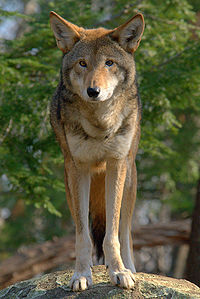Red Wolf
 From Conservapedia
From Conservapedia | Red wolf | |
|---|---|

| |
| Scientific classification | |
| Kingdom Information | |
| Domain | Eukaryota |
| Kingdom | Animalia |
| Subkingdom | Bilateria |
| Branch | Deuterostomia |
| Phylum Information | |
| Phylum | Chordata |
| Sub-phylum | Vertebrata |
| Infraphylum | Gnathostomata |
| Class Information | |
| Superclass | Tetrapoda |
| Class | Mammalia |
| Sub-class | Theriiformes |
| Infra-class | Holotheria |
| Order Information | |
| Superorder | Preptotheria |
| Order | Carnivora |
| Sub-order | Caniformia |
| Infraorder | Cynoidea |
| Family Information | |
| Family | Canidae |
| Sub-family | Caninae |
| Tribe Information | |
| Tribe | Canini |
| Genus Information | |
| Genus | Canis |
| Species Information | |
| Species | C. rufus |
| Population statistics | |
| Population | <150 (2008) |
| Conservation status | Critically endangered[1] |
The red wolf (Canis rufus) is a wild canid found in North America, and closely related to gray wolf. Critically endangered, the species was at one time extinct in the wild, but captive breeding allowed a successful, if somewhat guarded, reintroduction into several counties of North Carolina.
Description[edit]
Red wolves are clearly smaller than gray wolves. They have a length of about 53.5–63 inches from head to tail, and weigh about 50-85 pounds. Males are on average ten percent larger than females.
The color of the coat is reddish on many individual animals, but not always. Cinnamon, beige and blackish red wolves also occur. The reliable distinguishing feature which sets it apart from the gray wolf is therefore not the fur, but the much more graceful form. In addition, the red wolf has a narrower snout and proportionally larger ears.
Raccoons, rabbits and rodents are its main prey, with larger animals such as deer attacked only if they are sick and weakened. In addition, the red wolf will also feed on carrion.
Like gray wolves, red wolves live in packs, which are formed by a male/female parental pair and their younger cubs. A litter consists of three to six cubs, with up to twelve on rare occasions. Howls are less loud and bearing than that of the gray wolf, sounding like a mixture of wolves and coyotes.
Threats[edit]
The red wolf has been a rare animal throughout the later half of the 20th century with its overall numbers decreasing; by the early 1980's the species was listed as "endangered" by the IUCN, eventually upgraded to "critically endangered" by 1996. There are approximately 150-200 red wolves in a small area in northeastern North Carolina where they were reintroduced in 1987, and are believed to be slowly increasing in number.
Apart from the occasional vehicle collision, the major concern is hybridization with coyotes[2], which were not in the reintroduction area until the early 1990's. Current estimates maintain that if the red wolf is to survive with at least 90% genetic diversity for one hundred years, then there can be no more than one hybrid litter for every 59 litters, or an acceptable introgression rate of 1.7% of the total population. What was actually noted in the field research in 1999 was an introgression rate of 15%, which meant the disappearance of the species within 24 years. Management under the scope of the USFWS since 2000 has reduced introgression rate to approximately 4%[3].
References[edit]
- ↑ http://www.iucnredlist.org/details/3747/0
- ↑ http://eco.umass.edu/wp-content/uploads/2008/02/gese-et-al-2015.pdf
- ↑ https://www.fws.gov/redwolf/faq.html
Categories: [Canines]
↧ Download as ZWI file | Last modified: 03/12/2023 20:40:09 | 3 views
☰ Source: https://www.conservapedia.com/Red_wolf | License: CC BY-SA 3.0
 ZWI signed:
ZWI signed: KSF
KSF